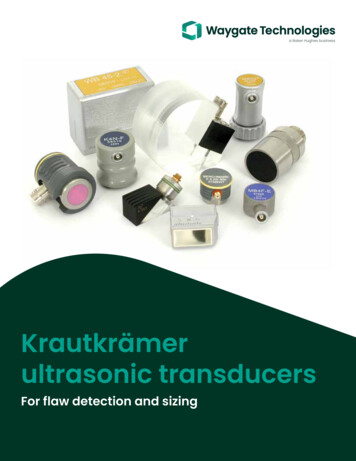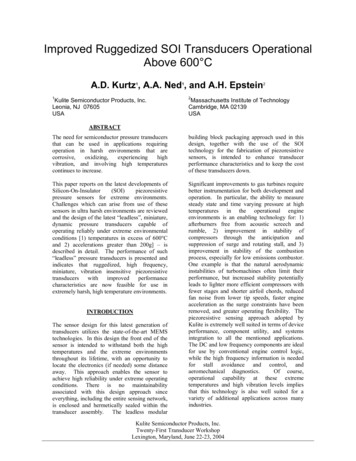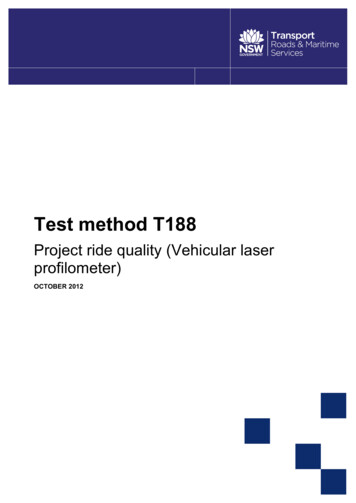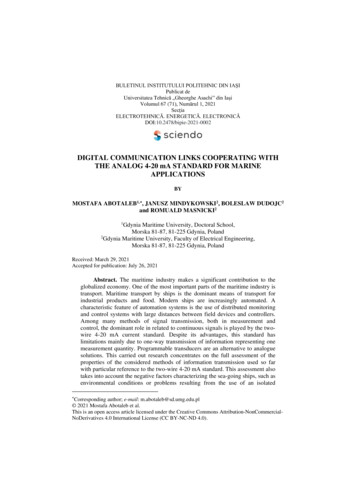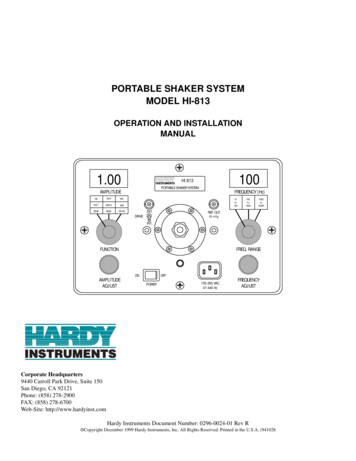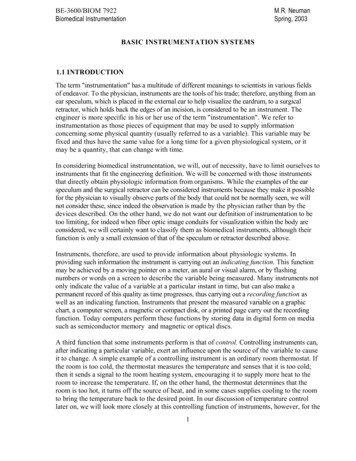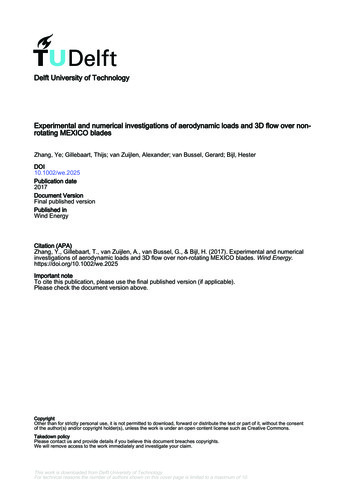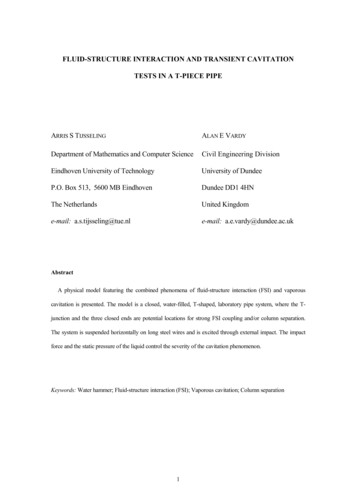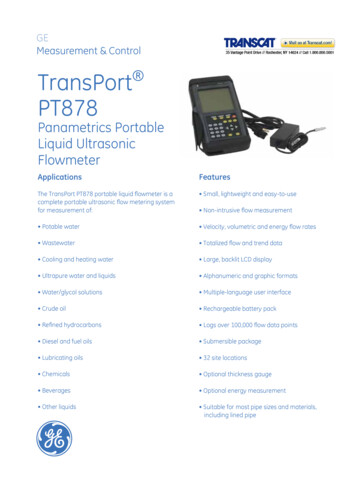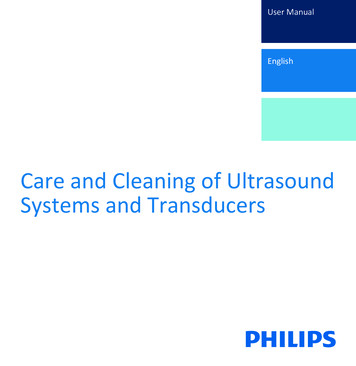
Transcription
User ManualEnglishCare and Cleaning of UltrasoundSystems and Transducers
ContentsContents1Read This First. 5Warning Symbols. 7Customer Comments. 7Customer Service. 8User Information Conventions. 8Supplies and Accessories. 94535 619 08041 A/795 * MAR 20172Safety. 11Warnings and Cautions. 11Latex Product Alert. 14FDA Medical Alert on Latex. 15Infection Control. 16Transmissible Spongiform Encephalopathy. 18Transducer Covers. 183System Cleaning and Maintenance. 21Disinfectants and Cleaners for System Surfaces. 21Cleaning and Disinfecting the System and ECG Equipment. 24Cleaning the System and ECG Equipment. 26Disinfecting System Surfaces and ECG Equipment. 27Lumify System Maintenance. 27Cleaning the Trackball. 28Philips HealthcareCleaning the System Air Filter. 28Cleaning and Disinfecting the AC Adapter. 304Transducer Care. 31Transducer Care Methods. 31Care and Cleaning of Ultrasound Systems and Transducers3
ContentsNon-TEE Transducer Care.Warnings and Cautions for Non-TEE Transducers.Cleaning Non-TEE Transducers, Cables, and Connectors.Low-Level Disinfecting Non-TEE Transducers.High-Level Disinfecting Non-TEE Transducers.Sterilizing Non-TEE Transducers.333541444649TEE Transducer Care.Warnings and Cautions for TEE Transducers.Guidelines for TEE Transducers.Cleaning, Disinfecting, and Sterilizing TEE Transducers by Immersion or AER.68697680Ultrasound Transmission Gels. 835Transducer Storage and Transport. 87Transducer Storage and Transport. 874535 619 08041 A/795 * MAR 2017USB Transducer Care. 52Warnings and Cautions for USB Transducers. 53Cleaning USB Transducers, Cables, and Connectors. 59Low-Level Disinfecting USB Transducers. 62High-Level Disinfecting USB Transducers. 64Sterilizing USB Transducers. 67Storage for Transport . 87Daily and Long-Term Storage. 876Disinfectants for Systems and Transducers. 89About Disinfectants. 89Factors Affecting Disinfectant Efficacy. 91Philips HealthcareChoosing Disinfectants and Cleaners. 914Care and Cleaning of Ultrasound Systems and Transducers
Read This First1 Read This FirstUltrasound systems and transducers require proper care, cleaning, and handling. Reasonablecare includes inspection, cleaning, and disinfection or sterilization, as necessary. This manualcontains information and instructions to help you effectively clean, disinfect, and sterilize yourPhilips ultrasound system and transducers. Additionally, these instructions help avoid damageduring cleaning, disinfection, and sterilization, which could void your warranty.The information in this manual is applicable to the following ultrasound systems: Affiniti series ClearVue series4535 619 08041 A/795 * MAR 2017 CX30 CX50 EPIQ series HD5 HD6 HD7 HD11 series HD15 iE33 iU22 Lumify SparqPhilips Healthcare Xperius (distributed by B. Braun)For information about Philips ultrasound systems or transducers that are not specificallymentioned in this document, see your system's User Manual, which contains information that isspecific to your system and transducers.Care and Cleaning of Ultrasound Systems and Transducers5
Read This FirstBefore you attempt to clean or disinfect a system or its transducers, read this manual andstrictly observe all warnings and cautions. Pay special attention to the information in the“Safety” section.For a list of disinfectants and cleaners that are compatible with your Philips ultrasound systemand transducers, see Disinfectants and Cleaning Solutions for Ultrasound Systems andTransducers (available with your system documentation) or the "Transducer and System Care"website:www.philips.com/transducercareFor a list of the transducers supported by your system, see your system User Manual, whichcontains information that is specific to your system and transducers. In North America, call Philips at 800-722-9377. Outside North America, contact your local Philips representative. Visit the "Transducer and System Care" website:www.philips.com/transducercareThis document and the information contained in it is proprietary and confidential informationof Philips Healthcare ("Philips") and may not be reproduced, copied in whole or in part,adapted, modified, disclosed to others, or disseminated without the prior written permission ofthe Philips Legal Department. This document is intended to be used either by customers, and islicensed to them as part of their Philips equipment purchase, or to meet regulatorycommitments as required by the FDA under 21 CFR 1020.30 (and any amendments to it) andother local regulatory requirements. Use of this document by unauthorized persons is strictlyprohibited.4535 619 08041 A/795 * MAR 2017For more information:Philips has taken care to ensure the accuracy of this document. However, Philips assumes noliability for errors or omissions and reserves the right to make changes without further notice toany products herein to improve reliability, function, or design. Philips may make improvementsor changes in the products or programs described in this document at any time.6Care and Cleaning of Ultrasound Systems and TransducersPhilips HealthcarePhilips provides this document without warranty of any kind, implied or expressed, including,but not limited to, the implied warranties of merchantability and fitness for a particularpurpose.
Warning SymbolsRead This FirstUnauthorized copying of this document, in addition to infringing copyright, might reduce theability of Philips to provide accurate and current information to users."xMATRIX" is a trademark of Koninklijke Philips N.V.Non-Philips product names may be trademarks of their respective owners.Warning Symbols4535 619 08041 A/795 * MAR 2017The system may use the following warning symbols. For additional symbols used on the system,see the "Safety" section in your system User Manual.Warning SymbolsSymbolDescriptionIdentifies a caution.Dangerous voltages: Appears adjacent to high-voltage terminals, indicating the presence ofvoltages greater than 1,000 Vac (600 Vac in the United States).Identifies ESD (electrostatic-discharge) sensitivity of a connector that is not tested asspecified in IEC 60601-1-2. Do not touch exposed connector pins. Touching exposed pinscan cause electrostatic discharge, which can damage the product.Indicates that the user should see the instructions for use for safety information.Philips HealthcareCustomer CommentsIf you have questions about the user information, or you discover an error in the userinformation, in the USA, please call Philips at 800-722-9377; outside the USA, please call yourlocal Philips customer service representative.Care and Cleaning of Ultrasound Systems and Transducers7
Read This FirstCustomer ServiceCustomer ServiceCustomer service representatives are available worldwide to answer questions and to providemaintenance and service. Please contact your local Philips representative for assistance. Youcan also contact the following office for referral to a customer service representative, or visitthe Philips Healthcare "Contact Us" celocator/index.wpdPhilips Ultrasound, Inc.22100 Bothell Everett Hwy, Bothell, WA 98021-8431, USAUser Information ConventionsThe user information for your product uses the following typographical conventions to assistyou in finding and understanding information: All procedures are numbered, and all subprocedures are lettered. You must complete stepsin the sequence they are presented to ensure success. Bulleted lists indicate general information about a particular function or procedure. They donot imply a sequential procedure.4535 619 08041 A/795 * MAR 2017800-722-9377 The left side of the system is to your left as you stand in front of the system, facing thesystem. The front of the system is nearest to you as you operate it. Transducers and pencil probes both are referred to as transducers, unless the distinction isimportant to the meaning of the text.Philips HealthcareInformation that is essential for the safe and effective use of your product appears throughoutyour user information as follows:8Care and Cleaning of Ultrasound Systems and Transducers
Supplies and AccessoriesRead This FirstWARNINGWarnings highlight information vital to the safety of you, the operator, and the patient.CAUTIONCautions highlight ways that you could damage the product and consequently void yourwarranty or service contract or ways that you could lose patient or system data.Notes bring your attention to important information that will help you operate the productmore effectively.Supplies and AccessoriesFor information on ordering supplies and accessories, see your system User Manual.Philips Healthcare4535 619 08041 A/795 * MAR 2017NOTECare and Cleaning of Ultrasound Systems and Transducers9
Supplies and AccessoriesPhilips Healthcare4535 619 08041 A/795 * MAR 2017Read This First10Care and Cleaning of Ultrasound Systems and Transducers
Warnings and CautionsSafety2 SafetyRead the information included in this section to ensure the safety of all persons operating andmaintaining ultrasound equipment, all patients participating in exams, and to ensure the qualityof the system and its accessories.Safety information that applies only to a specific cleaning or disinfection task is included in theprocedure for that task.4535 619 08041 A/795 * MAR 2017Warnings and CautionsFor maximum safety when using cleaners and disinfectants, observe the following warnings andcautions:WARNINGDisinfectants are recommended because of their chemical compatibility with productmaterials, not their biological effectiveness. For the biological effectiveness of a disinfectant,see the guidelines and recommendations of the disinfectant manufacturer, the U.S. Foodand Drug Administration, and the U.S. Centers for Disease Control.Philips HealthcareWARNINGThe level of disinfection required for a device is dictated by the type of tissue it will contactduring use and the type of transducer being used. Ensure that the disinfectant type isappropriate for the type of transducer and the transducer application. For information onthe levels of disinfection requirements, see “Transducer Care Methods” on page 31. Also,see the disinfectant label instructions and the recommendations of the Association forProfessionals in Infection Control, the U.S. Food and Drug Administration, and the U.S.Centers for Disease Control.Care and Cleaning of Ultrasound Systems and Transducers11
SafetyWarnings and CautionsWARNINGWhen sterilizing a transducer, ensure that the sterilant's strength and duration of contactare appropriate for sterilization. Be sure to follow the manufacturer's instructions.WARNINGIf a pre-mixed solution is used, be sure to observe the solution expiration date.Follow the recommendations of the disinfectant manufacturer.WARNINGTo avoid risk of electrical shock, do not use any transducer that has been immersed beyondthe specified cleaning or disinfection level.4535 619 08041 A/795 * MAR 2017WARNINGCAUTIONDo not use abrasive cleaners, or acetone, MEK, paint thinner, or other strong solvents onthe system, peripherals, or transducers.Do not use Sani-Cloth AF3 or Super Sani-Cloth to disinfect the system.12Care and Cleaning of Ultrasound Systems and TransducersPhilips HealthcareCAUTION
Warnings and CautionsSafetyCAUTIONOn display screens, do not use glass cleaners or products containing bleach. Immediatelywipe away disinfectants or cleaners to prevent residue buildup.CAUTIONOn display screens, use microfiber cloth; do not use paper towels.System surfaces and transducers are resistant to ultrasound gel, alcohol, and disinfectants,but if you use those substances, you must wipe them off to prevent permanent damage.CAUTIONUsing non-recommended disinfectants, using incorrect solution strengths, or immersing atransducer deeper or longer than recommended can damage or discolor the transducer andvoids the transducer warranty.Philips Healthcare4535 619 08041 A/795 * MAR 2017CAUTIONCare and Cleaning of Ultrasound Systems and Transducers13
SafetyLatex Product AlertCAUTIONCAUTIONSome cleaning and disinfectant products may result in discoloration if residual disinfectantand gel have not been completely removed between each use. Always remove gelcompletely before using cleaners and disinfectants. If necessary, where compatible for use,70% isopropyl alcohol may be used to remove residue buildup on system and transducercomponents.4535 619 08041 A/795 * MAR 2017On transducers with USB connectors, the only parts that may be cleaned with isopropylalcohol are the transducer housing and lens (acoustic window). On non-TEE transducers, theonly parts that may be cleaned with isopropyl alcohol are the connector housing and thetransducer housing and lens. On TEE transducers, the only parts that may be cleaned withisopropyl alcohol are the connector housing and the control housing. Ensure that thesolution is only 70% alcohol or less. Do not clean any other part of a transducer withisopropyl alcohol (including cables, USB connectors, or strain reliefs), as it can damage thoseparts of the transducer. This damage is not covered by the warranty or your servicecontract.Latex Product AlertPhilips ultrasound systems and transducers do not contain natural rubber latex that contactshumans.Transducer covers can contain natural rubber latex, which may cause allergic reactions insome individuals.14Care and Cleaning of Ultrasound Systems and TransducersPhilips HealthcareWARNING
Latex Product AlertSafetyWARNINGThe M2203A bite guard strap contains natural rubber latex, which may cause allergicreactions.FDA Medical Alert on Latex4535 619 08041 A/795 * MAR 2017March 29, 1991, Allergic Reactions to Latex-Containing Medical DevicesBecause of reports of severe allergic reactions to medical devices containing latex (naturalrubber), the FDA is advising health care professionals to identify their latex sensitive patientsand be prepared to treat allergic reactions promptly. Patient reactions to latex have rangedfrom contact urticaria to systemic anaphylaxis. Latex is a component of many medical devices,including surgical and examination gloves, catheters, intubation tubes, anesthesia masks, anddental dams.Reports to the FDA of allergic reactions to latex-containing medical devices have increasedlately. One brand of latex cuffed enema tips was recently recalled after several patients died asa result of anaphylactoid reactions during barium enema procedures. More reports of latexsensitivity have also been found in the medical literature. Repeated exposure to latex both inmedical devices and in other consumer products may be part of the reason that the prevalenceof latex sensitivity appears to be increasing. For example, it has been reported that 6% to 7% ofsurgical personnel and 18% to 40% of spina bifida patients are latex sensitive.Proteins in the latex itself appear to be the primary source of the allergic reactions. Although itis not now known how much protein is likely to cause severe reactions, the FDA is working withmanufacturers of latex-containing medical devices to make protein levels in their products aslow as possible.Philips HealthcareFDA’s recommendations to health professionals in regard to this problem are as follows: When taking general histories of patients, include questions about latex sensitivity. Forsurgical and radiology patients, spina bifida patients and health care workers, thisrecommendation is especially important. Questions about itching, rash or wheezing afterwearing latex gloves or inflating a toy balloon may be useful. Patients with positive historiesshould have their charts flagged.Care and Cleaning of Ultrasound Systems and Transducers15
SafetyInfection Control If latex sensitivity is suspected, consider using devices made with alternative materials, suchas plastic. For example, a health professional could wear a non-latex glove over the latexglove if the patient is sensitive. If both the health professional and the patient are sensitive,a latex middle glove could be used. (Latex gloves labeled “Hypoallergenic” may not alwaysprevent adverse reactions.) Whenever latex-containing medical devices are used, especially when the latex comes incontact with mucous membranes, be alert to the possibility of an allergic reaction. If an allergic reaction does occur and latex is suspected, advise the patient of a possiblelatex sensitivity and consider an immunologic evaluation.The FDA is asking health professionals to report incidents of adverse reactions to latex or othermaterials used in medical devices. (See the October 1990 FDA Drug Bulletin.) To report anincident, contact the FDA Problem Reporting Program, MedWatch, at 1-800-332-1088, or onthe Internet:www.fda.gov/Safety/MedWatch/For a single copy of a reference list on latex sensitivity, write to: LATEX, FDA, HFZ-220, Rockville,MD 20857.4535 619 08041 A/795 * MAR 2017 Advise the patient to tell health professionals and emergency personnel about any knownlatex sensitivity before undergoing medical procedures. Consider advising patients withsevere latex sensitivity to wear a medical identification bracelet.Infection ControlPhilips HealthcareIssues related to infection control affect the operator and the patient. Follow the infectioncontrol procedures established in your facility for the protection of both the staff and thepatient.16Care and Cleaning of Ultrasound Systems and Transducers
Infection ControlSafetyHandling Contaminated TransducersThe primary area of concern is the handling of transducers that have contacted infectedpatients. Always wear gloves when you handle transducers used in TEE, endocavity,intraoperative, and biopsy procedures that have not been previously disinfected. Forinformation on cleaning and disinfecting transducers, see the “Transducer Care” section.Removing Blood and Infectious Material from the SystemPhilips Healthcare4535 619 08041 A/795 * MAR 2017WARNINGIf the system becomes contaminated internally with bodily fluids carrying pathogens, youmust immediately notify your Philips service representative. Components inside the systemcannot be disinfected. In that case, the system must be disposed of as biohazardousmaterial in accordance with local or federal laws.CAUTIONOn transducers with USB connectors, the only parts that may be cleaned with isopropylalcohol are the transducer housing and lens (acoustic window). On non-TEE transducers, theonly parts that may be cleaned with isopropyl alcohol are the connector housing and thetransducer housing and lens. On TEE transducers, the only parts that may be cleaned withisopropyl alcohol are the connector housing and the control housing. Ensure that thesolution is only 70% alcohol or less. Do not clean any other part of a transducer withisopropyl alcohol (including cables, USB connectors, or strain reliefs), as it can damage thoseparts of the transducer. This damage is not covered by the warranty or your servicecontract.Use a gauze pad moistened with soap and water to remove blood on the system and thetransducer connectors and cables. Then dry the equipment with a soft cloth to preventcorrosion. You can use a 70% solution of isopropyl alcohol only on certain parts of the systemand certain parts of some transducers. Additional cleaning agents are available. For moreCare and Cleaning of Ultrasound Systems and Transducers17
SafetyTransmissible Spongiform Encephalopathyinformation, see Disinfectants and Cleaning Solutions for Ultrasound Systems and Transducers.For more information about removing blood and other infectious material from the system, seethe “System Cleaning and Maintenance” section.ECG Cables and Lead SetsFor information on cleaning ECG cables and lead sets, see the “System Cleaning andMaintenance” section.WARNINGIf a sterile transducer cover becomes compromised during an intraoperative applicationinvolving a patient with transmissible spongiform encephalopathy, such as CreutzfeldtJakob disease, follow the guidelines of the U.S. Centers for Disease Control and thisdocument from the World Health Organization: WHO/CDS/ APH/2000/3, WHO InfectionControl Guidelines for Transmissible Spongiform Encephalopathies. The transducers for yoursystem cannot be decontaminated using a heat process.4535 619 08041 A/795 * MAR 2017Transmissible Spongiform EncephalopathyTransducer CoversTo prevent contamination by blood-borne pathogens, sterile transducer covers are required forneedle guidance procedures. Philips and B. Braun recommend the use of qualified covers.Philips HealthcareFor procedures for using transducer covers, see the instructions provided with the covers.18Care and Cleaning of Ultrasound Systems and Transducers
Transducer CoversSafetyWARNINGLatex and talc are commonly used in sheaths marketed to help with infection control intransesophageal, endocavity, and intraoperative imaging applications and during needleguidance and biopsies. Examine the packaging to confirm latex and talc content. Studieshave shown that patients can experience allergic reactions with natural rubber latex. Seethe FDA Medical Alert, March 29, 1991, reprinted in “FDA Medical Alert on Latex” on page15.4535 619 08041 A/795 * MAR 2017WARNINGIn intraoperative applications, sterilized transducers should be used with sterile gel and asterile transducer cover.WARNINGInspect transducer covers before and after use.WARNINGDo not apply the transducer cover until you are ready to perform the procedure.WARNINGPhilips HealthcareIf an installed transducer cover is cut or contaminated before use, the transducer should becleaned and disinfected, and a new sterile cover installed.Care and Cleaning of Ultrasound Systems and Transducers19
SafetyTransducer CoversWARNINGPhilips Healthcare4535 619 08041 A/795 * MAR 2017Sterile transducer covers are disposable and must not be reused.20Care and Cleaning of Ultrasound Systems and Transducers
Disinfectants and Cleaners for System SurfacesSystem Cleaning and Maintenance3 System Cleaning and MaintenanceMaintenance should be performed regularly and as needed.Because the system is a piece of medical equipment that contains several circuit boards,extensive service diagnostics, and complex operating software, Philips recommends that onlytrained personnel service the system.4535 619 08041 A/795 * MAR 2017It is important to clean and maintain the ultrasound system and peripherals. Thorough cleaningis important for pieces of peripheral equipment, because they contain electromechanicaldevices. If exposed to constant and excessive environmental dust and humidity, these deviceswill suffer in both performance and reliability.It is essential to clean the transducers used with your ultrasound system. The cleaningprocedures vary for the different types of transducers and their uses. For detailed instructionson how to clean and maintain each type of transducer used with the system, see the“Transducer Care” section.WARNINGAlways use protective eyewear and gloves when cleaning, disinfecting, or sterilizing anyequipment.CAUTIONPhilips HealthcareFollow all instructions provided to avoid damage during cleaning, disinfection, andsterilization. Failure to do so could void your warranty.Disinfectants and Cleaners for System SurfacesThis information applies to all systems except for Lumify, which is covered under “LumifySystem Maintenance” on page 27.Care and Cleaning of Ultrasound Systems and Transducers21
System Cleaning and MaintenanceDisinfectants and Cleaners for System SurfacesThe compatibility of disinfectants and cleaners varies depending on the item on which they areused. The products in the following table are compatible with these system surfaces: External plastic and painted surfaces of system and cart System control panel ECG trunk cables, leads, and electrodes Touch screens and monitor screens Easy-clip transducer cable managersMild soap solution1Cleaning Solutions for TouchScreens and Monitor ScreensDisinfectants for System Surfaces and Touch Screens Mild soap solution1 70% isopropyl alcohol (IPA) Cleaners designed for LCDs Opti-Cide3 (QUAT/IPA based) Purified water Oxivir Tb (accelerated hydrogen peroxide based) PI-Spray II (QUAT based) Protex spray or wipes (compatible with EPIQ series,Affiniti series, and Xperius systems only) Sani-Cloth HB (QUAT based) Sani-Cloth Plus (QUAT/IPA based)1.4535 619 08041 A/795 * MAR 2017Cleaning Solutionsfor All SurfacesMild soap solutions do not contain any harsh ingredients and are not irritating to the skin.They must not contain fragrance, oils, or alcohols. Hand sanitizers are not approved foruse.D
Care and Cleaning of Ultrasound Systems and Transducers 5 Philips Healthcare 4535 619 08041_A/795 * MAR 2017 Read This First Ultrasound systems and transducers require proper care, cleaning, and handling. Reasonable care includes inspection, cleaning, and disinfection or sterilization, as necessary. This manual
